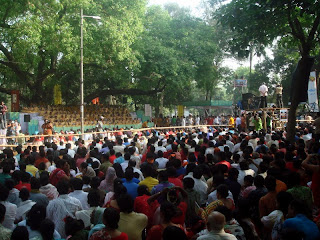
Songs rendered by 'Chhayanaut' group at Ramna Batamul






Mongol Shobhajatra
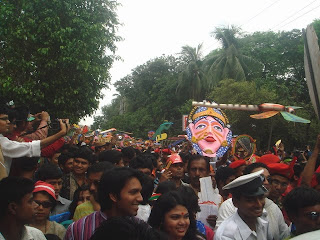

Masks procession (Pic. Daily Star)




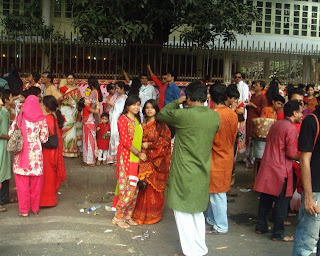



masks prepared at Fine Arts Faculty
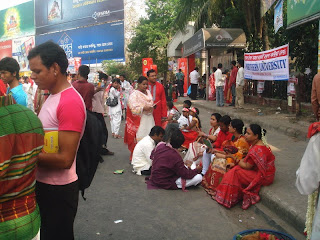
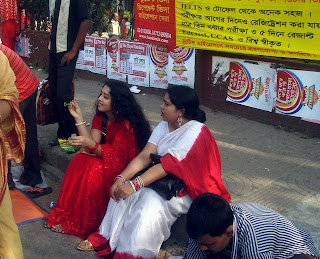

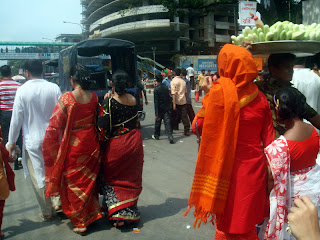


The day was very hot and humid

Tender fruits of Coconut


street vending of special cake by Japanese group at Banglamotor attracted huge crowd

aiming bottles with tennis ball

The first day of the Bengali calendar 'Pohela Boishakh' has evolved into a day of celebration and became an integral part of the Bengali culture and tradition as people's festival irrespective of religion, sect and creed. In the early years, on the first day of the Bengali calendar, the traders and shopkeepers opened 'halkhata' (fresh accounts) for settling the accounts of the year gone by and served sweetmeats to their clients. In Dhaka now, the day begins with elaborate cultural programmes:-' Chhayanaut' a noted cultural group welcomes the day with presentation of songs and dance at the 'Botomul' pavement of Ramna park (since 1965). The students of the Institute of Fine Arts and Dhaka University bring out colourful mask procession (Mongol Shobhajatra since independence) seeking well-being for all, singing with the beats of traditional musical instruments. Other institutions in urban areas also organise day long programme, fanfare. Street shops in city offer snacks of soaked rice and hilsha fish (paanta-ilish-bhorta) poor man's staple meal.
The Bengali Calender was introduced during the period Mughal ruler, Akbar the great. Before that the agricultural taxes were collected from farmers according to the Islamic 'Hijri' calendar. As the Hijri calendar is a lunar one, the agricultural year did not always coincide with the fiscal year. As a result, farmers were hard-pressed to pay taxes out of season. Emperor Akbar who ruled India from 1556 AD (963 Hijri) ordered a reform of the calendar to streamline and ease tax collection processes. Amir Fatehullah Shirazi, a renowned scholar and talented astronomer of Persian ancestry in his royal court was given the task of formulating the new calendar. The calendar that finally came out was found to suit to the crop pattern and harvesting of the empire particularly the eastern region, the traditional granary of the empire. In keeping with the harvesting season, this new calendar initially came to be known as the Harvest Calendar, or ফসলী সন Fôsholi Shôn.
The Fôsholi Shôn calendar was introduced on 10 March / 11 March 1584, but was dated from Akbar's accession to the throne in 1556 CE. The calendar subsequently became known as বাংলা সন Bangla Shôn or বঙ্গাব্দ Bônggabdo ("Bengali year"). The calendar was popular in eastern South Asia due to its adaption to reflect the unique seasonal patterns of the region- summer, rainy, fall, dry, winter and spring. The Bengali Era 963 BS had been in synchrony with then used 963 Hijri era, the year of accession in thrown of Akbar in 1556 CE .
The name of months in the Bangla calendar were different from those adopted by modern version. Originally, the twelve months were known under the Persian names as Farwadin, Ardi, Vihisu, Khordad, Teer, Amardad, Shahriar, Aban, Azur, Dai, Baham and Iskander Miz.
The Bengali Calendar was officially implemented throughout the Mughal empire. After the fall of Mughal rule, the calendar was abandoned in some regions except Bengal, Assam and Tripura.
In 1966, the Calendar was modified further to match the Gregorian system by a committee headed by the celebrated scholar Dr. Muhammad Shahidullah under the auspices of the Bangla Academy on 17 February1966. The Committee made the following observations:
The length of a year in the Bengali calendar, as in the Gregorian calendar, is counted as 365 days. However, the actual time taken by the earth in its revolution around the sun is 365 days 5 hours 48 minutes and 47 seconds. To make up this discrepancy, the Gregorian calendar adds an extra day, to make a leap year, to the month of February every fourth year (except in century years and not divisible by 400). The Bengali calendar, which was based on astronomical calculations, did not make this extra leap year adjustment. Bengali months, too, were of different lengths. To counter this discrepancy, and to make the Bengali calendar more precise, the committee made the following recommendations:
1. The first five months of the year from Boishakh to Bhadro will consist of 31 days each.
2. The remaining seven months of the year from Ashshin to Choitro will consist of 30 days each.
3. After each fourth year, an additional day will be added in the month of Falgun.
Bangladesh follows the modified calender (luni-solar) Bangla calendar since 1988. It was, however, not fully followed in the neighbouring Bengali speaking states of West Bengal and Tripura of India where the calender did not correspond with their Hindu religious festivals. People in West Bengal observes Bengali new year on 14/15 April depending on the appearance of moon whereas in Bangladesh it's 14 April.
